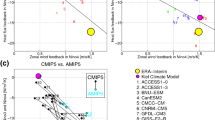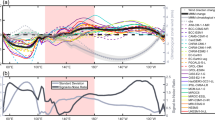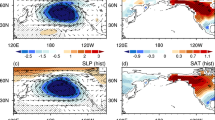Abstract
There is still considerable uncertainty concerning twentieth century trends in the Pacific Walker Circulation (PWC). In this paper, observational datasets, coupled (CMIP5) and uncoupled (AGCM) model simulations, and additional numerical sensitivity experiments are analyzed to investigate twentieth century changes in the PWC and their physical mechanisms. The PWC weakens over the century in the CMIP5 simulations, but strengthens in the AGCM simulations and also in the observational twentieth century reanalysis (20CR) dataset. It is argued that the weakening in the CMIP5 simulations is not a consequence of a reduced global convective mass flux expected from simple considerations of the global hydrological response to global warming, but is rather due to a weakening of the zonal equatorial Pacific sea surface temperature (SST) gradient. Further clarification is provided by additional uncoupled atmospheric general circulation model simulations in which the ENSO-unrelated and ENSO-related portions of the observed SST changes are prescribed as lower boundary conditions. Both sets of SST forcing fields have a global warming trend, and both sets of simulations produce a weakening of the global convective mass flux. However, consistent with the strong role of the zonal SST gradient, the PWC strengthens in the simulations with the ENSO-unrelated SST forcing, which has a strengthening zonal SST gradient, despite the weakening of the global convective mass flux. Overall, our results suggest that the PWC strengthened during twentieth century global warming, but also that this strengthening was partly masked by a weakening trend associated with ENSO-related PWC variability.









Similar content being viewed by others
References
Allan R, Ansell T (2006) A new globally complete monthly historical gridded mean sea level pressure dataset (HadSLP2): 1850–2004. J Clim 19(22):5816–5842. doi:10.1175/jcli3937.1
Bentsen M, Bethke I, Debernard JB, Iversen T, Kirkevåg A, Seland Ø, Drange H, Roelandt C, Seierstad IA, Hoose C, Kristjánsson JE (2012) The Norwegian Earth System Model, NorESM1-M—part 1: description and basic evaluation. Geosci Model Dev Discuss 5(3):2843–2931. doi:10.5194/gmdd-5-2843-2012
Bjerknes J (1966) A possible response of the atmospheric Hadley circulation to equatorial anomalies of ocean temperature. Tellus 18(4):820–829. doi:10.1111/j.2153-3490.1966.tb00303.x
Cane MA, Clement AC, Kaplan A, Kushnir Y, Pozdnyakov D, Seager R, Zebiak SE, Murtugudde R (1997) Twentieth-century sea surface temperature trends. Science 275(5302):957–960
Chylek P, Li J, Dubey MK, Wang M, Lesins G (2011) Observed and model simulated 20th century Arctic temperature variability: Canadian Earth System Model CanESM2. Atmos Chem Phys Discuss 11(8):22893–22907. doi:10.5194/acpd-11-22893-2011
Collins M (2005) El Niño-or La Niña-like climate change? Clim Dyn 24(1):89–104
Collins M, An S-I, Cai W, Ganachaud A, Guilyardi E, Jin F-F, Jochum M, Lengaigne M, Power S, Timmermann A, Vecchi G, Wittenberg A (2010) The impact of global warming on the tropical Pacific Ocean and El Nino. Nat Geosci 3(6):391–397
Compo GP, Sardeshmukh PD (2010) Removing ENSO-related variations from the climate record. J Clim 23(8):1957–1978. doi:10.1175/2009jcli2735.1
Compo GP, Whitaker JS, Sardeshmukh PD, Matsui N, Allan RJ, Yin X, Gleason BE, Vose RS, Rutledge G, Bessemoulin P, Brönnimann S, Brunet M, Crouthamel RI, Grant AN, Groisman PY, Jones PD, Kruk MC, Kruger AC, Marshall GJ, Maugeri M, Mok HY, Nordli Ø, Ross TF, Trigo RM, Wang XL, Woodruff SD, Worley SJ (2011) The twentieth century reanalysis project. Q J R Meteorol Soc 137(654):1–28. doi:10.1002/qj.776
Dai A, Wigley TML (2000) Global patterns of ENSO-induced precipitation. Geophys Res Lett 27(9):1283. doi:10.1029/1999gl011140
Deser C, Phillips AS, Alexander MA (2010) Twentieth century tropical sea surface temperature trends revisited. Geophys Res Lett 37(10). doi:10.1029/2010gl043321
DiNezio PN, Vecchi GA, Clement AC (2013) Detectability of changes in the Walker Circulation in response to global warming. J Clim 26(12):4038–4048. doi:10.1175/jcli-d-12-00531.1
Dunne JP, John JG, Adcroft AJ, Griffies SM, Hallberg RW, Shevliakova E, Stouffer RJ, Cooke W, Dunne KA, Harrison MJ, Krasting JP, Malyshev SL, Milly PCD, Phillipps PJ, Sentman LT, Samuels BL, Spelman MJ, Winton M, Wittenberg AT, Zadeh N (2012) GFDL’s ESM2 global coupled climate-carbon earth system models. Part I: physical formulation and baseline simulation characteristics. J Clim 25(19):6646–6665. doi:10.1175/JCLI-D-11-00560.1
Gent PR, Danabasoglu G, Donner LJ, Holland MM, Hunke EC, Jayne SR, Lawrence DM, Neale RB, Rasch PJ, Vertenstein M, Worley PH, Yang Z-L, Zhang M (2011) The community climate system model version 4. J Clim 24(19):4973–4991. doi:10.1175/2011jcli4083.1
Griffies SM, Winton M, Donner LJ, Horowitz LW, Downes SM, Farneti R, Gnanadesikan A, Hurlin WJ, Lee H-C, Liang Z, Palter JB, Samuels BL, Wittenberg AT, Wyman BL, Yin J, Zadeh N (2011) The GFDL CM3 coupled climate model: characteristics of the ocean and sea ice simulations. J Clim 24(13):3520–3544. doi:10.1175/2011JCLI3964.1
Guan B, Nigam S (2008) Pacific sea surface temperatures in the twentieth century: an evolution-centric analysis of variability and trend. J Clim 21(12):2790–2809. doi:10.1175/2007JCLI2076.1
Held IM, Soden BJ (2006) Robust responses of the hydrological cycle to global warming. J Clim 19(21):5686–5699. doi:10.1175/jcli3990.1
Hurrell JW, Hack JJ, Shea D, Caron JM, Rosinski J (2008) A new sea surface temperature and sea ice boundary dataset for the community atmosphere model. J Clim 21(19):5145–5153. doi:10.1175/2008jcli2292.1
Ishii M, Shouji A, Sugimoto S, Matsumoto T (2005) Objective analyses of sea-surface temperature and marine meteorological variables for the 20th century using ICOADS and the Kobe collection. Int J Climatol 25(7):865–879. doi:10.1002/joc.1169
Karnauskas KB, Seager R, Kaplan A, Kushnir Y, Cane MA (2009) Observed strengthening of the zonal sea surface temperature gradient across the equatorial pacific ocean*. J Clim 22(16):4316–4321. doi:10.1175/2009jcli2936.1
Knutson TR, Manabe S (1995) Time-mean response over the tropical Pacific to increased C02 in a coupled ocean-atmosphere model. J Clim 8(9):2181–2199
Latif M, Keenlyside NS (2009) El Niño/southern oscillation response to global warming. Proc Natl Acad Sci 106(49):20578–20583. doi:10.1073/pnas.0710860105
L’Heureux ML, Lee S, Lyon B (2013) Recent multidecadal strengthening of the Walker Circulation across the tropical Pacific. Nature Clim Change 3(6):571–576. doi:10.1038/nclimate1840
Lindzen RS, Nigam S (1987) On the role of sea surface temperature gradients in forcing low-level winds and convergence in the tropics. J Atmos Sci 44(17):2418–2436. doi:10.1175/1520-0469(1987)044<2418:otross>2.0.co;2
Luo J-J, Sasaki W, Masumoto Y (2012) Indian Ocean warming modulates Pacific climate change. Proc Natl Acad Sci 109(46):18701–18706. doi:10.1073/pnas.1210239109
Meng Q, Latif M, Park W, Keenlyside NS, Semenov VA, Martin T (2012) Twentieth century Walker Circulation change: data analysis and model experiments. Clim Dyn 38(9–10):1757–1773. doi:10.1007/s00382-011-1047-8
NCAR (2012) The NCAR command language [Software]. 6.0.0 edn. UCAR/NCAR/CISL/VETS, Boulder, CO. doi:10.5065/d6wd3xh5
Penland C, Matrosova L (2006) Studies of El Niño and interdecadal variability in tropical sea surface temperatures using a nonnormal filter. J Clim 19(22):5796–5815. doi:10.1175/JCLI3951.1
Penland C, Sardeshmukh PD (1995) The optimal growth of tropical sea surface temperature anomalies. J Clim 8(8):1999–2024. doi:10.1175/1520-0442(1995)008<1999:TOGOTS>2.0.CO;2
Power SB, Kociuba G (2011) What caused the observed twentieth-century weakening of the Walker Circulation? J Clim 24(24):6501–6514. doi:10.1175/2011jcli4101.1
Rayner NA, Parker DE, Horton EB, Folland CK, Alexander LV, Rowell DP, Kent EC, Kaplan A (2003) Global analyses of sea surface temperature, sea ice, and night marine air temperature since the late nineteenth century. J Geophys Res 108(D14):4407. doi:10.1029/2002jd002670
Reynolds RW, Rayner NA, Smith TM, Stokes DC, Wang W (2002) An improved in situ and satellite SST analysis for climate. J Clim 15(13):1609–1625. doi:10.1175/1520-0442(2002)015<1609:AIISAS>2.0.CO;2
Richter JH, Sassi F, Garcia RR, Matthes K, Fischer CA (2008) Dynamics of the middle atmosphere as simulated by the Whole Atmosphere Community Climate Model, version 3 (WACCM3). J Geophys Res 113(D8):D08101. doi:10.1029/2007JD009269
Riley WJ, Subin ZM, Lawrence DM, Swenson SC, Torn MS, Meng L, Mahowald NM, Hess P (2011) Barriers to predicting changes in global terrestrial methane fluxes: analyses using CLM4Me, a methane biogeochemistry model integrated in CESM. Biogeosciences 8(7):1925–1953. doi:10.5194/bg-8-1925-2011
Schmidt GA, Ruedy R, Hansen JE, Aleinov I, Bell N, Bauer M, Bauer S, Cairns B, Canuto V, Cheng Y, Del Genio A, Faluvegi G, Friend AD, Hall TM, Hu Y, Kelley M, Kiang NY, Koch D, Lacis AA, Lerner J, Lo KK, Miller RL, Nazarenko L, Oinas V, Perlwitz J, Perlwitz J, Rind D, Romanou A, Russell GL, Sato M, Shindell DT, Stone PH, Sun S, Tausnev N, Thresher D, Yao M-S (2006) Present-day atmospheric simulations using GISS ModelE: comparison to in situ, satellite, and reanalysis data. J Clim 19(2):153–192. doi:10.1175/jcli3612.1
Shin S-I, Sardeshmukh PD (2011) Critical influence of the pattern of Tropical Ocean warming on remote climate trends. Clim Dyn 36(7–8):1577–1591. doi:10.1007/s00382-009-0732-3
Smith TM, Reynolds RW (2004) Improved extended reconstruction of SST (1854–1997). J Clim 17(12):2466–2477. doi:10.1175/1520-0442(2004)017<2466:IEROS>2.0.CO;2
Sohn BJ, Park S-C (2010) Strengthened tropical circulations in past three decades inferred from water vapor transport. J Geophys Res 115:(D15). doi:10.1029/2009jd013713
Solomon A, Newman M (2012) Reconciling disparate twentieth-century Indo-Pacific ocean temperature trends in the instrumental record. Nat Clim Change 2(9):691–699. doi:10.1038/nclimate1591
Solomon S, Qin D, Manning M, Alley RB, Berntsen T, Bindoff NL, Chen Z, Chidthaisong A, Gregory JM, Hegerl GC, Heimann M, Hewitson B, Hoskins BJ, Joos F, Jouzel J, Kattsov V, Lohmann U, Matsuno T, Molina M, Nicholls N, Overpeck J, Raga G, Ramaswamy V, Ren J, Rusticucci M, Somerville R, Stocker TF, Whetton P, Wood RA, Wratt D (2007) Technical summary. In: Climate change 2007: the physical science basis. Contribution of working group I to the fourth assessment report of the intergovernmental panel on climate change. IPCC, Cambridge, UK, New York, NY, USA
Taylor KE, Stouffer RJ, Meehl GA (2011) An overview of CMIP5 and the experiment design. Bull Am Meteorol Soc 93(4):485–498. doi:10.1175/BAMS-D-11-00094.1
Tjiputra JF, Roelandt C, Bentsen M, Lawrence DM, Lorentzen T, Schwinger J, Seland Ø, Heinze C (2012) Evaluation of the carbon cycle components in the Norwegian Earth System Model (NorESM). Geosci Model Dev Discuss 5(4):3035–3087. doi:10.5194/gmdd-5-3035-2012
Tokinaga H, Xie S-P, Timmermann A, McGregor S, Ogata T, Kubota H, Okumura YM (2011) Regional patterns of tropical Indo-Pacific climate change: evidence of the Walker Circulation weakening. J Clim 25(5):1689–1710. doi:10.1175/jcli-d-11-00263.1
Tokinaga H, Xie S-P, Deser C, Kosaka Y, Okumura YM (2012) Slowdown of the Walker circulation driven by tropical Indo-Pacific warming. Nature 491(7424):439–443. doi:10.1038/nature11576
Vecchi GA, Soden BJ (2007) Global warming and the weakening of the tropical circulation. J Clim 20(17):4316–4340. doi:10.1175/jcli4258.1
Vecchi GA, Soden BJ, Wittenberg AT, Held IM, Leetmaa A, Harrison MJ (2006) Weakening of tropical Pacific atmospheric circulation due to anthropogenic forcing. Nature 441(7089):73–76. doi:10.1038/nature04744
Wang B, Liu J, Kim H-J, Webster P, Yim S-Y (2012) Recent change of the global monsoon precipitation (1979–2008). Clim Dyn 39(5):1123–1135. doi:10.1007/s00382-011-1266-z
Watanabe M, Suzuki T, O’ishi R, Komuro Y, Watanabe S, Emori S, Takemura T, Chikira M, Ogura T, Sekiguchi M, Takata K, Yamazaki D, Yokohata T, Nozawa T, Hasumi H, Tatebe H, Kimoto M (2010) Improved climate simulation by MIROC5: mean states, variability, and climate sensitivity. J Clim 23(23):6312–6335. doi:10.1175/2010jcli3679.1
Wilks DS (2011) Statistical methods in the atmospheric sciences, vol 100. Academic press, Waltham
Wu T (2012) A mass-flux cumulus parameterization scheme for large-scale models: description and test with observations. Clim Dyn 38(3–4):725–744. doi:10.1007/s00382-011-0995-3
Xie S-P, Deser C, Vecchi GA, Ma J, Teng H, Wittenberg AT (2010) Global warming pattern formation: sea surface temperature and rainfall. J Clim 23(4):966–986. doi:10.1175/2009JCLI3329.1
Yukimoto S, Adachi Y, Hosaka M, Sakami T, Yoshimura H, Hirabara M, Tanaka TY, Shindo E, Tsujino H, Deushi M, Mizuta R, Yabu S, Obata A, Nakano H, Koshiro T, Ose T, Kitoh A (2012) A new global climate model of the meteorological research institute: MRI-CGCM3; model description and basic performance. J Meteorol Soc Jpn 90A:23–64. doi:10.2151/jmsj.2012-A02
Acknowledgments
S.S. and F.S. acknowledge the financial support of the Research Council of Norway through the funding of the project SoCOCA (190159/V10). The Norwegian national supercomputing (NOTUR) resources of Hexagon (Project nn2345k) and Norstore (Project ns2806k) were extensively used in this work. The twentieth century reanalysis Project used resources of the National Energy Research Scientific Computing Center managed by Lawrence Berkeley National Laboratory and of the Oak Ridge Leadership Computing Facility at Oak Ridge National Laboratory, which are supported by the Office of Science of the U.S. Department of Energy under Contract No. DE-AC02-05CH11231 and Contract No. DE-AC05-00OR22725, respectively. Support for the twentieth century reanalysis Project dataset is provided by the U.S. Department of Energy, Office of Science Innovative and Novel Computational Impact on Theory and Experiment (DOE INCITE) program, and Office of Science (BER), and by the National Oceanic and Atmospheric Administration Climate Program Office. The research of P.D.S. and G.P.C was supported by the Office of Science (BER), U.S. Department of Energy and by the NOAA Climate Program Office. The CMIP5 coupled model simulations were obtained from Program for Climate Modeling Inter-comparison (PCMDI), which is a part of World Climate Research Program, and we thank each modeling group for providing their data. The authors thank J. Hurrell of NCAR for help in understanding differences in SST datasets. For providing their SST data, we thank the Hadley Centre, N. Rayner, and BADC for HadISST, NOAA/NCDC and T. Smith for ERSST, and the JMA and M. Ishii for COBE.
Author information
Authors and Affiliations
Corresponding author
Rights and permissions
About this article
Cite this article
Sandeep, S., Stordal, F., Sardeshmukh, P.D. et al. Pacific Walker Circulation variability in coupled and uncoupled climate models. Clim Dyn 43, 103–117 (2014). https://doi.org/10.1007/s00382-014-2135-3
Received:
Accepted:
Published:
Issue Date:
DOI: https://doi.org/10.1007/s00382-014-2135-3




